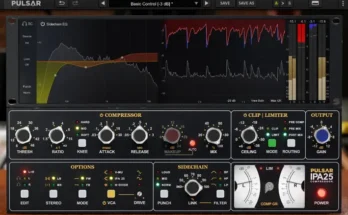18 Feb 2020 | WIN: 3.6 GB | OSX:4.04 GB
Electric Bass was sampled from a Yamaha BB424x electric bass guitar. The bass was modified so that individual pickups were wired to independent jacks, thus allowing for independent sampling of the bridge and neck pickups. Volume and tone pots were bypassed, so resistors were wired in their place to minimize the “ice pick” sound of an electric bass without pots. The pickups were then run into individual Radial 48 active direct boxes and Grace 101 preamps, which provided additional gain.
Sampling began by recording with the target of 4 velocity layers with 5 note round-robin. The strings of the bass were kept relatively bright and fresh. Nearly the entire bass was sampled in this manner, but the results were unsatisfactory, so the bass was re-sampled from the beginning with 10 velocity layers, 4-note round robin, and mellow strings.
Notes were gently plucked and fiercely attacked, so that playing low velocities generates a warm sound with subtle attack, well higher velocity notes become more percussive. By playing soft or hard, blending between neck and bridge pickups, and applying eq, a variety of tones can be achieved. However, the intention was to make a nice-sounding “utility” bass library that blends easily into the mix, and to offer the user a standard go-to bass that can serve as a reference for other bass libraries.
Slide articulations were recorded in three-note round robin and can be triggered via the pitch wheel. Major and minor third slide up and slide downs were recorded for most strings, the exception being open E1 and whenever a slide would place the note beyond the recorded range of the bass. Slides were recorded at a tempo of 120 BPM. Like other notes, slides can be released.
Care was taken to find the best strings on which to sample notes. Strings were cleaned periodically, in order to maintain a consistent sound.
* Range From E1 To C4
* Individually Sampled Pickups
* 10 Velocity Layers, 4-Note Round-Robin
* 8 GB Of Sample Data
* Supports 44.1, 48, 88.2, and 96 kHz
ENGINEERING
The Kontakt version of Adam Monroe’s Electric Bass is now depreciated (1.22.2020). The VST, Audio Unit, and AAX versions are programmed entirely by AdamMonroeMusic. The goal in any sample library that is also a VSTi (virtual instrument), Audio Unit, or AAX plugin is to attempt to match the performance of the Kontakt Player. With this library, we feel like we have done just that.
The VST, Audio Unit, and AAX versions include updated, high-performance algorithms that have been improving with each new virtual instrument released by Adam Monroe Music. For example, the buffering algorithm is double-buffered and multithreaded, which means that buffering performance is fast, even on slower computers, and even at lower latencies. Voices are held and iterated over in a pure, C-Style array. Memory use is comparable to the (depreciated) Kontakt version – around 390MB . Because of the solid VST, AU, AAX code base, you can feel confident that the VST, AU, and AAX versions will work just as well as the (depreciated) Kontakt version.
The VST, AU, and AAX versions also include automatic sample-rate conversion, supporting 44.1, 48, 88.2, and 96 kHz sample rates.
Why develop a VST, Audio Unit, or AAX version at all? Although a great piece of software, the full version of Kontakt (required to run 3rd party sample libraries) is expensive. Developing a VST, Audio Unit, or AAX version that anyone can use does not add significant time to the development of an Electric Bass library – most of the time is spent sampling and processing the samples – so it’s a real no-brainer. Another advantage is that effects processing code potential in the VST, AU, and AAX versions is limitless, while in a Kontakt version you are limited to scripting and built-in effects.
Audio engineering is a large part of creating a VST, AAX, or Audio Unit plugin, but the sounds of this electric bass library have barely been processed. No eq tweaks were made, as the tone can be shaped dramatically by blending between pickups. Brightness can be dialed back with the “tone” knob, which is essentially a HPF.
CHANGELOG v1.3:
The plugin now includes a drive knob, which adds built-in distortion and gain.
The plugin has also been updated to be OS X Catalina compatible.
Features of the Plugin Include:
Drive and Tone Knobs.
Individually sampled pickups.
Sampled slides.
4X Round-Robin and 10 Velocity layers.
[toggle title=”Home page”]https://tinyurl.com/rfp2cp4[/toggle]

http://alfalink.to/8caf654d6bf5eb4930c1
Please REPORT in Comment Broken Links




